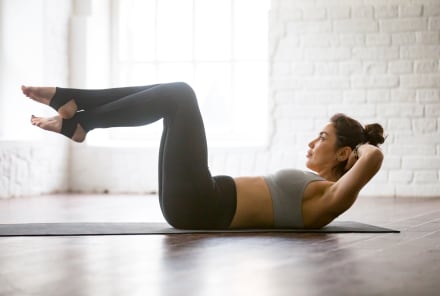Advertisement
Why Is It Harder To Run Outside Than On A Treadmill?

Ray Bass is the associate movement and wellness editor at mindbodygreen and a NASM-Certified Personal Trainer. She holds a degree in creative writing from the University of Pennsylvania, with honors in nonfiction.
Whenever I train for a race, regardless of the season, I somehow end up logging some miles on the treadmill.
I never really plan for it; it just happens, and only sometimes. I know some people can’t stand treadmills (and are perhaps turning their noses up at this second), but when life gets in the way a treadmill can feel like a true godsend.
Inclement temperatures and traveling are the two obstacles I run into the most, and in those situations, I’m more than happy to trot on a tread.
While running inside and outside both have their own benefits and drawbacks, there’s no denying that running outside tends to be more difficult.
Sure, most runners prefer running outside, but they don’t do it because it’s physically easier—depending on the terrain and conditions, it’s usually much harder.
So what’s the deal—why is running outside harder? Well, there are a few reasons.
Running outside means you have to deal with the weather.
As Elizabeth Corky, elite marathoner, RRCA-certified running coach told mbg, “Weather is definitely a challenge only outdoor runners experience. If you want to run outdoors, you have to learn to work with nature and adapt to it.”
Of course, this is easier said than done. Personally, nothing zaps my motivation more than running in the rain, the cold, or both.
When I’m training, sometimes there’s no avoiding it, but poor conditions make long runs even more difficult, both physically and mentally.
Getting myself up a hill is hard enough—add some rain and a few more miles ahead of me, and it’s all the more strenuous.
You don’t have the same predictability and control that you do on a treadmill.
Running on a treadmill means that you can set the pace and the incline, which control the difficulty of the run.
If you’re running with a specific time or pace in mind, it’s much easier to guarantee that result on a treadmill.
"A great thing about running on the treadmill is that once you set your speed, you don't have to think about it anymore,” says Corinne Fitzgerald, NSCA-certified personal trainer, triathlete, and running coach. “All you have to do is keep pace with the belt."
You get the same terrain on a treadmill, whereas it’s unpredictable (or at least varies more) outside.
If I run six miles on the treadmill and then run six miles in Central Park, well, those are two very different runs.
While yes, you can adjust the incline and speed on the treadmill, there’s no true replacement for the earth under your feet; the treadmill just doesn’t have the same impact on our bodies.
“You simply cannot replace what it’s like to run on solid ground,” says Corky. “And biomechanics can often change with treadmill running. Outside, the terrain forces you to handle what’s in front of you.”
That said, treadmill running isn’t a walk in the park either.
While the physical demands of running outdoors are typically higher, some would argue that the mental taxes of a treadmill make it a tough alternative.
Exercising outside has a plethora of psychological benefits, and in my experience, it’s more enjoyable because it’s less repetitive.
“Treadmills are mentally a thousand times more challenging to handle than running outside,” Corky notes. “It’s also very easy to get into a running rut—hopping on the treadmill and doing the exact same thing all the time.”
As I mentioned before, there’s room for both running inside and outside in any training plan or exercise routine.
They both have their benefits and drawbacks. Most runners (including myself) will say if you’re able to run outside, you should go for it.
But if you’re in a bind or something’s standing in your way, the best run is the one you’ll actually do. Hop on that treadmill and get to work.

Short On Time? Try This Personal Trainer's 5-Minute Full-Body Workout
Krista Stryker, NSCA-CPT

Short On Time? Try This Personal Trainer's 5-Minute Full-Body Workout
Krista Stryker, NSCA-CPT

Short On Time? Try This Personal Trainer's 5-Minute Full-Body Workout
Krista Stryker, NSCA-CPT

Short On Time? Try This Personal Trainer's 5-Minute Full-Body Workout
Krista Stryker, NSCA-CPT









